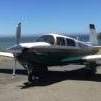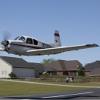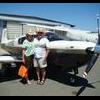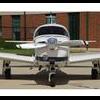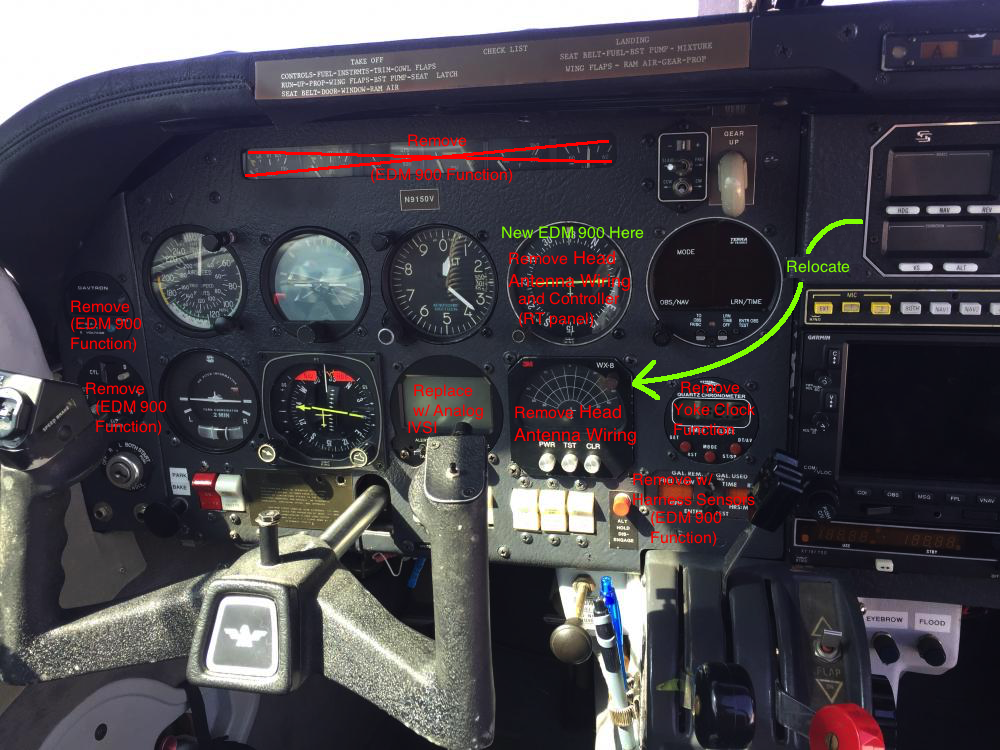Leaderboard
Popular Content
Showing content with the highest reputation on 02/21/2017 in all areas
-
I don't fear hot starts. Taught by transition instructor. Shut down at 1100 rpm by pulling mixture. On start up. Do nothing except crank. Then add mixture when fires. How do you know it is flooded? When you add mixture and it dies. When flooded. Open throttle full open, closed mixture. Crank. When fires, do the two handed dance on mixture and throttle to keep running.5 points
-
Great flight down to S. Fla. We had the plane packed to the gills. Cargo compartment filled with cooler, tent, chairs, etc. My poor girlfriend was in the back seat and was practically squished against her window with blankets and pillows. At 9,500 it was cold enough she was snuggled against them. We averaged 145KTAS, so I'm happy with it. We were about 100lbs under gross on takeoff, I could've brimmed the tanks (tookoff at 90% fuel) and still had more weight. She was asleep once we reached 9,500ft. Passing Lakeland. Such a fitting name. There were probably 100 people and maybe 30 aircraft that showed up. Most of the pilots there were my age, but a lot more experienced career-types. Most of which were Riddle CFIs, etc,etc. There was a spot landing contest, pancake breakfast, BBQ lunch and dinner, and on both nights, a nice campfire and dubious amounts of alcohol involved. The 8-hour bottle to throttle rule was strictly adhered to. It was mainly a frat-party, so not my type of thing, but its has brought my appreciation to older pilots and the wisdom they share. I can't say I am thrilled with my generation of pilots, at least the ones that didn't "earn their keep" and grow up to respect it. But overall, a fun camping experience. She really does love sleeping Total time: 182.8 hrs, total time in type: 70.15 points
-
3 points
-
I have an old quart mason jar and a custom cut piece of tubing that sits inside the mason jar which holds it up against the drain. Get in pull ring, switch tanks, pull ring. then inspect jar. Then put fuel in tug.2 points
-
Our O-360 was using 1 qt every 15+ hours. Then rebuilt one cylinder (low compression due to a burnt exhaust valve) and oil consumption immediately jumped up to 1 qt every 3-4 hours. After ~15 hours, replaced that rebuilt cylinder with another cylinder and re-ringed piston, and now oil is back down to 1 qt every 10-15 hours.2 points
-
2 points
-
Unfortunately some early 252's did not have two alternators since it was an option. The single alternator 252's have a reputation for eating up batteries pretty often. Scroll down to the highlighted portion of this pdf for K model alternator comments: M20K PRE-BUY highlighted.pdf2 points
-
I owned a '66E from 1977 to 1988 flying it about 2500 hours. Early on I switched to fine wire plugs and I supposed I might have put 2000 hours on them. When I bought another E 5 years ago it had Champion massives. The second time I had to taxi back to the maintenance shop from the run up area with a fouled plug I ordered a set of Tempest fine wires. There is no comparison.2 points
-
Just FYI, Paul is a contributor and fellow Mooney owner on this site. He helped me diagnose a problem similar to your problem. I fortunately caught the issue on the ground. Prior flights showed no issues. The two spark plugs in my #2 cylinder decided to start failing. From the SavvyAnalysis display of my JPI data you will see two arrows I placed on it. This is a ground mag check of my plane. The red arrow shows when the spark plug on that mag completely died. Essentially running on 3 cylinders. The blue arrow shows me taxiing back to the hangar on one spark plug. I pulled the plugs and checked the resistance. They (and most of the others) failed the resistance test. I replaced all of the spark plugs with Tempest fine wires. Sent from my iPad using Tapatalk Pro2 points
-
Restarting in the air after running a tank dry is not an issue I've done it several times on long flights. The injected engines in my experience usually quit pretty quickly when out of fuel since there is no fuel bowl like on carburetors. The engine continues to spin at RPM no starter is needed. Close throttle (so you don't get an engine over-speed when it gets fuel), switch tanks, boost pump on she will fire up quickly advance throttle to previous setting adjust mixture for cruise if necessary. You may experience some roughness at first but that passes quickly and could just be imaginary. Oh also warn your passenger that it is coming so they don't have a heart attack. I've been able to catch it pretty much as soon s the engine start to lose RPM knowing it is coming.2 points
-
"Total time: 182.8 hrs, total time in type: 70.1" It's amazing how quickly the hours start adding up when you own your own plane. :-)2 points
-
Log book entry. "Complied with AD 75-09-08 by installation of engine mount gussets IAW Mooney SB M20-192A."2 points
-
2 points
-
i think Guitarmaster is showing his view of the instruments in the picture. I have the same view with mine. Not a problem when mounted properly and unless you are all the way forward in the seat position you should have plenty of range in adjusting it. My opinion is if you are using your iPad for instrument flight it has to be mounted on the yoke rather than your lap because the latter is vertigo inducing. But for VFR it doesn't matter at all IMO. I use the MyGoFlight yoke mount with their plastic case as Turtle shows above for its superior adjust ability. (He must be a smart guy! )2 points
-
Cody, you need to update your tail number. And tell the ladies and gentlemen who's plane you got to play with over the weekend.2 points
-
The PMA is really a quality system approval. The center of this is the quality manual, which defines all facets of manufacture and ap sale of PMA approved parts. This could include STC parts or other parts that are intended for ones own STC or others, or duplicate parts. If the corporation is sold intact, it is likely easily transferred, start chopping it up and all bets are off. I suspect that the business is best left intact, but that limits potential buyers to those who wish to live in that area or can find a good remote manager. This is a tough one, it would be my dream business, but it's in the wrong place for me and I don't have the capital anyway. I really hope they find the right buyer, since they have had such a positive influence on most Mooney owners.2 points
-
Oil on the bottom plugs is due to worn piston rings or intake valves bushings. There is nothing else you can do. José2 points
-
Absolutely. I don't think it is possible to put in a G500 or Aspen without a "backup" per their stc. It might be possible with the ESI and the G5, but dumb to do if your 1970's technology Analog King AP needs analog pitch and roll inputs to drive it. That is probably the one reason why the scrap metal recyclers are not full of KI25x's right now, and why Mr. Bramble can live in beautiful Sarasota Fl. L3, Please come out with an D/A converter to drive the AP for your great ESI500!2 points
-
Final follow up (hopefully) . . . after looking over the relay that I pulled, it was definitely burned. So when the new relays came in I replaced both relays for a grand total of $43.68 with tax and shipping and everything works great now . . and yes I'm replacing the tied up string with a zip tie and yes there's a black plastic cover that goes over the relays.2 points
-
Thought some of you considering this upgrade might find interesting. Picked up plane on Friday after the ADS-b upgrade. Had GNS430 upgraded to WAAS for GPS source and installed a new GTX345. Paired up bluetooth on the iPad mini 2 with the GTX345 successfully and started the one hour flight home. I noticed Foreflight's screen was locked up after about 10 minutes into the flight and I could not zoom or move the screen. Also noticed iPad wouldn't calibrate straight and level from the GTX345 AHRS feed. Had other similar issues on the next flight with the combo such as the bluetooth link dropping out on Foreflight's devices page. Didn't spend a lot of time trying to trouble shoot in the air. Contacted Foreflight support and they know of problems with the bluetooth linkage and are working to try and get them resolved with Garmin. As a interim measure Foreflight support suggests to me that turning Bluetooth off in Settings page of the iPad Mini2 and then back on is a temporary fix but it will happen again until this issue is worked out. I don't know if other brands of EFB's are having similar issues maybe some of you can chime in on your combo's? Otherwise the GNS430w and GTX345 combo is working nicely together and wished I could have done it sooner. Bill1 point
-
I do the following with pretty good success: Master On Throttle Full (WOT) Mixture Full (Rich) Boost Pump On Count 6 Mississippis Mixture Cut Off Boost Pump Off *Throttle back to just cracked **Wait 10-30 seconds ***Start *I usually set the throttle right past the point where I feel the click for the gear warning circuit, about 1/4" **I usually wait longer in winter than in summer for the fuel to vaporize. This little bit of wait can help a lot. ***When it's cold in winter, particularly if the plane was sitting or I could not get a preheat, the last thing I do before cranking for the start is get out (with the mags and master off) and turn the prop about 6 times (3 full rotations) by hand. I treat it like a hot prop as though I am hand propping just in case for safety. Then I jump back in and it fires on the first or second blade. This helps a lot in winter because the battery is outputting poorly and the starter is making pathetic wimpy turns. This way I save the couple turns it will make before it fires by doing it by hand and let it get right to the point of having a quick start. For a hot-start, I put mixture cut off and throttle full and start cranking. When it seems about ready to fire or if a few seconds have gone by, I bring the throttle back to normal starting position and keep cranking till it fires.1 point
-
Last time I put on an immersion suit, it took me 10 minutes or so to struggle into it and another to extract myself. I'd take the chicken way across near dover. Wouldn't it just take 1/2 hour longer to slide down the coast a bit? Maybe I'm just thinking about the frozen (or almost) lakes around here. I think the channel is mid 40's. Seems almost balmy in comparison.1 point
-
Also in a ditching if you can keep your head and after leaving the mooney can close vents and doors ,they have been known to float for a while1 point
-
1 point
-
1 point
-
WOT, full rich mixture, pump for about 4 seconds (6 when c o l d), let it sit for about five to ten seconds, crack the throttle and let her rip. First or second blade every time!1 point
-
If you do a search of "articulating seat" you'll find that Mooney sells them for $3500 each for the frame, you add the upholstery. They usually sell used for around $2000 each, you add the upholstery. The used ones seem to go fast for that price.1 point
-
Yup. BTW I've heard about the intake valve guide problem causing oil recirculation in the combustion chamber but I'm not sure how common it is. I asked the shop that just reconditioned two of my jugs, and they seemed to think it is very rare on the O-360s. I just went through something similar. I would not overhaul cylinders - makes no sense with new cylinders being relatively cheap. If the cylinders are first run, you can IRAN them - will cost $300-500/cylinder, plus a ton of labor. Might end up totaling 6-8amu to do all 4. Keep in mind if a crack is found after they are pulled and cleaned, you will need a new one. But that's a lot to invest in a 1600 smoh engine. Since you have issues with all 4, in your shoes I might just live with it and monitor closely until the engine gives you another reason to overhaul. I just did 2 cylinders on mine (burnt exhaust valve on one, oily plug on another), but I have 800 smoh and am hoping the investment will get me a lot more use. So far I'm satisfied with the decision since oil consumption dropped from <3hrs/qt to >10hrs/qt and oil no longer turns black quickly. BTW i think the prior owner's operating experience and yours with the CHTs is pretty typical for Cs, but it's no wonder that we end up needing so much cylinder work with those temps. I tightened up my doghouse further when the cylinder work was done, but it seems to have made zero difference. I know other folks have reported better results from baffling work, which I think is worthwhile, but after much effort I've come to the conclusion that it's an intrinsically bad design on these old carb'd planes.1 point
-
What to do next? Paul at Savvy indicates... 1) Run-up procedure can be run better to see the data more clearly. Add 20 seconds between each step both, right, both, left, both... 2) even without a clear run-up, there seems to be at least one bad spark plug. Typical JPI data collection takes one data point every 6 seconds. Too slow to catch data unless you wait extra long... Typical spark plug issues are made by Champion. Check the resistance of the plugs. Often they become too high resistance on their own. They look right. But they are not right. Something that can be done now.... perform a run-up on the ground with extended run time between different mag selections. Verify the rise on each of the EGTs when a single mag is operating. This should clearly show which is a bad plug. measure the resistance of the bad plug, read the name of the manufacturer of the plug. theses are Private pilot ideas, not from a mechanic. Ideas that have been seen here before. Continue to use Savvy as a tool to determine what is really going on inside your engine. people have posted pictures of all their spark plugs. people have measured and posted the resistance on all of their spark plugs. the other issues mentioned... 1) fuel blockage in the fuel injectors. There is a test for that using baby food jars to measure the flow of fuel in each injector over time. 2) check your airframe log books to see how old the sealant might be. There is a screen at the fuel tank selector that is somewhat easy to access. This screen/separator can often tell what is going on in the fuel tanks. Rust, dirt, and water often show up here... 3) push to talk and grounding issues disturbing the JPI data? Time to look into the grounding straps, engine, airframe and instrument panel... 4) posting a video of what you are seeing can be done using YouTube. Consider posting a video of your run-up. As I typed before.... theses are Private pilot ideas, not from a mechanic. Ideas that have been seen here before. Best regards, -a-1 point
-
It takes about 5 seconds in the case of my E model for the fuel pressure to peak. Perhaps a little longer if cold.1 point
-
1 point
-
+1 Switch to Tempest fine wire plugs, a Concorde battery and DMax's simple hot start technique should work fine. The IO360 is easy to flood so best practice is to err on the side of fuel starvation by cranking with the mixture in cut off position w/o the boost pump. If engine doesn't catch quickly I pump the red knob once. As soon as it shows a sign of catching quit cranking and give it a little mixture while getting the left hand to the throttle.1 point
-
I have been doing the following for 15 years in my IO360. Works everytime. At shutdown - At idle (1000RPM), mixture to cutoff. - Pretty much a normal shutdown, things should be as normal as possible anyway. Startup - Master switch on, leave throttle where it was (if you accidently moved it, no problem just crack it slightly above idle) - mixture stays in cutoff. NO FUEL PUMP!!!! (you will flood the engine for sure!) - now start the engine it will turn over 3 or 4 times then fire, bring mixture to rich as it fires. The only time I was having major issues getting started it turned out I need my mags overhauled.....1 point
-
One more thread that makes me glad I fly behind an O-360 . . . Stopped for fuel Sunday, added 27 gals to top off, pumped throttle once, mixture rich, turn & push key--purr. Right on 1000 RPM (I sometimes miss by a couple hundred RPM, but Sunday was nice).1 point
-
Try this, for Lycoming IO models only: Throttle and mixture fully forward for 10 seconds or more. If you watch the fuel pressure gauge you'll see the fuel pressure drop to 0. So now you have no fuel in the lines. I do this as soon as I get in, then adjust the seat, seat belts, etc while waiting. Pull throttle back to what would be 1200 rpm setting or so, mixture to ICO. Pressurize the fuel system by using boost pump just for a second, then without delay start as normal. By emptying the fuel lines you are putting in cool fuel and always starting from the same state as oppose to have some of the fuel vaporized out. Starts will be smoother and won't cough and stutter. The problem with other techniques is they may work fine for a short fuel stop but not longer stops, or work when cool but not hot. This insures every hot start is the same, starting from the same state. Whether it's been 5 minutes or 25, 10° or 90°.1 point
-
Basically my method and works 99.9% of the time. When it doesn't you either have too much or too little fuel and just need to figure out which. End of the day when in doubt flood it and do the two handed dance.1 point
-
If it gets worse with altitude it can be either a failing mechanical fuel pump or fuel starting to form vapor on the pump inlet line from the firewall. Insulating that like with extra fire sleeve did it for me1 point
-
Steven: I own a repair station at KMQS in PA. http://www.sureflight.com 136 nm from KISP. We bought a Mooney 205 that we are refurbishing: paint, interior, and avionics. We changed all the windows including the windshield with a Great Lakes Areo .250" extra thick windshield. We can replace your windshield and professionally repaint the lower retainer after it is riveted back on. Feel free to email me at dwatkins@sureflight.com me if you are interested. Here is a few photos from our install last month.1 point
-
You have to try it,it works fine for many of us and I'd go a step further that with a good mount system it should guarantee getting a satisfactory view. But not everyone is willing to spend the money it may take. You will see lots of example of mountings other than the yoke. There are no shortage of these. But whatever you opt for, be sure to consider the crash worthiness of which ever mount you choose. Our steel cage will remain intact at well over 9g's -about the most we'll survive properly restrained. Most fatals are due to blunt force trauma to the head and chest so avoid adding anything sharp and protruding that could lead to injuries. My self personally, I have always been very leary of mounts above the yoke that can lead to flying ipad in a crash or provide another rigid obstruction to hit.1 point
-
1 point
-
Pro tip if you choose to use ty wraps is to cut them with fingernail clippers. It rounds the edges off. Or Snap on has some small flush cut dykes that will remove harmful edges. I have two pairs that have a nose broke off one of the cutter. If you drop them on pavement the nose breaks.1 point
-
Two way communication helps get to the root of so many problems... 1) Customers giving factual feed back... in flight video is the best feedback a supplier can hope for. 2) Suppliers keeping an ear open... our Avidyne contact has been exceptional at this.... 3) One user giving another user ideas to follow up on... CNOE giving the most recent example in the post above... The power of MS... Best regards, -a-1 point
-
1 point
-
Use the rule of thumb for pricing a plane... But this time, reverse the order... If you are buying from a professional sales guy, you know he has some leeway built in to a competitive price. If you are buying from a guy that sells a plane every decade or two, he may not even know what the price should be... There is always plenty of room for negotiation... there is plenty of time to decide... Until, there is just one other person looking to do the same thing you are. Suddenly, the rules change... The time to negotiate is when everyone is selling... Buy straw hats in the middle of winter. Buy winter coats in the middle of summer. End of season sales are really good. Last I looked there are no rules for pricing airplane's for sale. The rule of thumb that I Have seen around here is your first plane that you try to buy gets away before you get serious. After that happens, you know exactly what you want and how much you are willing to pay to get it... negotiations go into high speed mode right after that moment. There is a guideline for pre-owned Mooney prices. It is printed in a good Mooney Newsletter that gets mentioned around here often. The guideline is put together by the people that sell Mooney's at All American Aircraft. Never give away the opportunity to use a PPI... even expensive newish planes need a PPI... Best regards, -a-1 point
-
1 point
-
Nice. Saturation is normal through most of training. I particularly had issues with the radio. I knew what to say until I keyed the mic, and then I would freeze. I would also miss calls from the tower occasionally in the beginning. With time and practice you eventually wonder why you found it difficult.1 point
-
David, just give me a ring! I should be around the Silverwings cabin as I volunteer to help them every year (driving friends around in a golf cart ), or at the SAFE booth, or doing a FAAsteam presentation, or harassing Dirk Vanderzee or Richard Simile at the Mooney Booth1 point
-
Na......it ain't that sensitive to seating position, probably more rotational force from the prop spinning Sent from my iPhone using Tapatalk1 point
-
If it is windy I land with them out. Cuts down on the floating when I just want to get the airplane on the runway.1 point




